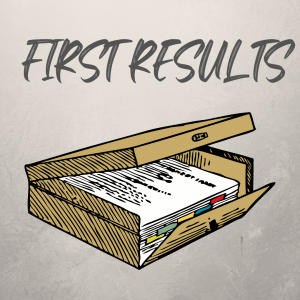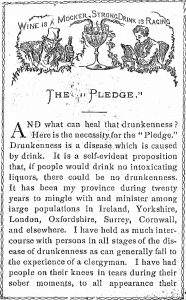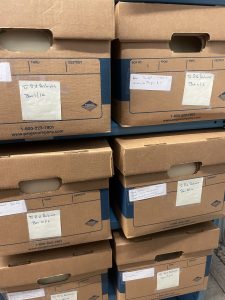There’s nothing more inspirational than the first few tangible results of a project. In this case, they are visible rather than tangible, it’s a digital archive after all. It reminds me that, in physical archives, I’d like to think users minimize touching precious items as much as I have so far with this collection: once I have an item in hand, I insist on doing it all, from removing paperclips to scanning the whole thing.
For these initial results, credit must be given to all who handled the materials before:
 anonymous donors or heirs of their estates, who, instead of chucking those boxes of old papers, brought them to the Alcohol Library;
anonymous donors or heirs of their estates, who, instead of chucking those boxes of old papers, brought them to the Alcohol Library;- anonymous library staff members, who took good care of them via sorting, organizing, and preserving the documents and images;
- anonymous library student workers, who did the grunt work of removing paperclips and rehousing the material in acid-free, archival folders, and scanned thousands of files;
- anonymous graduate assistants, who helped organize the collection, supervised scanning, and even used parts of the Alcohol Archive collection for their schoolwork as a digital collection prototype.
I am constantly reminded of their generous contributions while digging deeper in an area. Humbled and worried at the same time, I should take this job very seriously: one can’t let down so many people.
I am constantly reminded that, without our conscientious colleagues, it would be impossible for me now to locate and identify any of the materials (both physical and digital) and they would be lost for research by future generations of scholars, i.e., peers of the authors and creators of the items in the collection.

The Pledge: a written pledge of abstinence from alcohol, giving a list of reasons (Temperance Collection)
Accomplishments
1. Uploading the first large batch of files into the Publications Collection of RUcore is complete. This covers all digitized publications and related files that had been digitized and available in other versions, all copyrighted to the Center, a total of 201 documents.
2. The documents (pdfs) of Summer School Collection mostly done, same parameters as above, a total of 133 pdfs. By “done,” in addition to completing the upload, I also mean:
- Drupal pages created, linked to RUcore content
- Link on this WordPress site’s updated pointing to RUcore content
- Creative canned searches added the all pages with a link pointing to the appropriate results in RUcore (see examples in the Quick Links section of One Day at a Time)
3. A small subcollection of the Special Collections section called the ”Temperance Collection” had been uploaded to RUcore (by Kate Greenberg), a total of 54 files.
New discoveries
- The downtime during uploads can be used (rather safely) for other, small tasks (on multiple screens, I work with four!) if one is not too tired to keep track of them all. But don’t even think about borderline multitasking at the end of your workday! That’s when systems tend to crash, causing duplicates and other errors.
- Running parallel updates to Drupal AND WP works the best, other than updating the master spreadsheet, researching content, and double checking files just uploaded.
- Templates in WMS are a godsend when processing identical or similar items, such as annual publications (the of Summer School Program Brochures and Alumni Newsletters).
- There are advantages to both a large-scale flatbed scanner with autofocus and page splitting capabilities as well as the one with an auto document feeder. They fulfill different needs. It’s unfortunate that, unlike at the CAS library, all that doesn’t come in the same machine (or is available at the same location). But, I learned to work with what I have, in this case, my good old HP M175, right next to my computer, complementing the miracle scanner at Annex.
Concerns
- Missing / poor quality files are still my biggest concern. Discovering a break in the sequence of Summer School Program Brochures slowed me down significantly only to realize that one can focus only one task at a time: finish what you’re doing, take an inventory of the missing years, and go on a hunt later.
- Same with the Alumni Newsletters, but with bigger gaps, another list, which also lists them as the source (or at least the creation date) of many related images to deal with later.
- On top of all that, the Center has been famous for changing its own name, events, publication, and series titles. You name, they changed it, going back to the 1940s. It happened more than once that, while on autopilot, I let the template dictate and had to redo the record!
 To do
To do
Print material
- continue to analyze content of boxes with unfinished processing (Blume, Keller, and Milgram boxes) in Annex
- take care of unattended tasks, such as content missing from folders, as needed
- search for content not yet digitized but important and available (in the discarded items box), assess options
- digitize select newly discovered content such as items about RU CAS and SSAS history
- consolidate spreadsheets (a.k.a. The Ledger) for different collections
- round up and assess collected images audiovisual files
- plan to start shifting from uploading pdfs to audiovisual materials soon: new templates and workflows
- convert jpgs (suitable for Omeka) to tiff (mandated for RUcore) after testing a small batch
- assign additional tasks to grad student based on her newly acquired skills
Takeaway: Keep it simple
- For productivity: Do one of each task EVERY day: prep & upload, Drupal & WordPress
- Plan ahead for the unexpected, budget 20% more time than you think you need for a task
- Remember to use VPN (even if timing upload after business hours)
- Restart computer before each session in the morning
Statistics
Number of files uploaded so far
- Omeka: 86 images
- RUcore: 390 pdfs
Pages and posts created so far
- Drupal: 74 pages, 68 media items
- WordPress: 54 pages, 64 posts, 358 media items